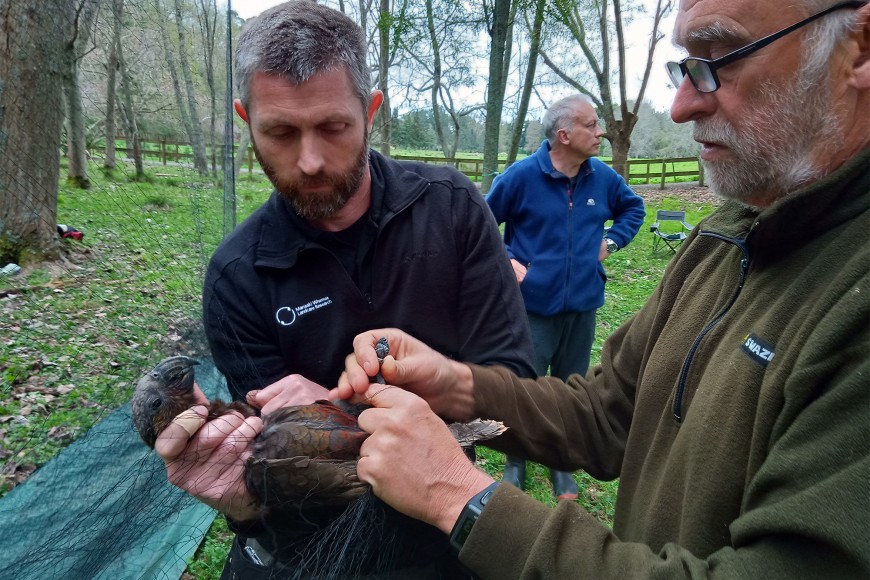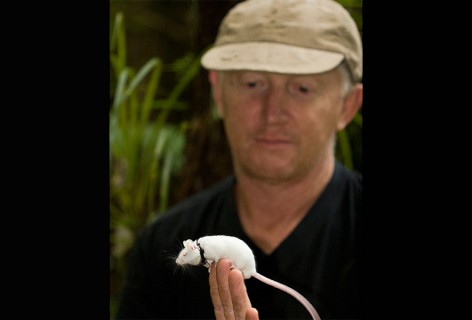Forest bird movements and sociality
Connectivity between forests is therefore a double-edged sword. It is helpful when all the connected habitats are safe for the species concerned, but unhelpful if one or more destination sites are unsafe.
Manaaki Whenua researchers John Innes and Neil Fitzgerald worked with colleagues from the Museum of New Zealand Te Papa Tongarewa, Massey University, and Parker Conservation to review what is known about forest bird movement behaviour. They searched publications and talked to experts to collate all available accounts of how far forest birds have been observed to cross pasture and water gaps between forests, and to collate accounts of the diets and social systems of birds that might explain how and where they move.
One early conclusion of the researchers is that robust information about the movement of most forest birds is scarce, and gap-crossing distances are unknown for some species. Observed movements may be of exceptional individuals in unusual circumstances and may not apply to most birds in a population. Readers should note that the following accounts are generally based on few observations and should be regarded as provisional until more observations are made.
Using current data, they classed four species (NI kōkako, pōpokatea/whitehead, tīeke/South Island (SI) saddleback and NI brown kiwi as strongly gap-limited, being not known to cross water or pasture gaps between forests larger than 500 m. A further eight species (mohua/yellowhead, titipounamu/rifleman, pīpipi/brown creeper, weka, tīeke/NI saddleback, kakaruwai/SI robin, toutouwai / NI robin and miromiro/tomtit) are moderately gap-limited, not observed to cross 5 km gaps.
The remaining 16 forest birds range widely and readily across forest gaps larger than 5 km over water or pasture. This ‘weakly gap-limited’ category includes nectar-, fruit-, and seed-eating species such as kākā, kākāriki, kererū, tūī and korimako/bellbirds. These species are known to be wide-ranging, presumably to find seasonal foods based on flowering and fruiting patterns that are variable across landscapes. This category of bird also includes predatory birds such as kāhu/harrier, kārearea/falcon, and ruru/morepork that hunt over large areas, as well as pīpīwharauroa / shining cuckoo and koekoeā / long-tailed cuckoo, which migrate 5000-plus km annually from Pacific islands to breed in New Zealand forests.

Neil Fitzgerald (MWLR) and Peter Dilks (DOC) extract a NI kākā – a big mover across landscapes – from a mist-net near Hamilton, part of a collaborative study of kākā movements. Watching for other birds is Terry Greene (DOC).
Most insectivores defend territories year-round, although some species, such as pōpokatea/whitehead, mohua/yellowhead, tauhou/silvereye, red-crowned kākārirki and hihi/stitchbird are territorial in the breeding season but more mobile outside it, sometimes forming mixed-species flocks that year-round territorial birds such as pīwakawaka/fantails and riroriro/grey warblers may join. Winter flocks may offer protection from predators, or extra food because flocks disturb prey or are more efficient at finding food than scattered individuals.
The fruit- and nectar-feeders and carnivores that were noted above to be good gap-crossers tend to defend only small spaces around the nest in the breeding season, but otherwise overlap feeding sites with others of the same species, and they range widely in the non-breeding season. These mobile species, such as kererū and kākāriki, historically formed huge flocks that are absent today. It is now fascinating to contemplate the behaviours and ecological roles of such flocks, and they deserve research.
Significance for conservation
Although some forest birds are strongly gap-limited and so cannot move freely between remaining forest fragments, the researchers do not think this absence of connectivity is a critical problem yet for New Zealand conservation. This is because the main widespread factor that limits bird populations is safety from mammalian predators and the forest areas that can cost-effectively be made safe on the New Zealand mainland at the moment are quite small. A recent review of ecosanctuaries found that their average area was about 700 ha.
In fact, connectivity can be a disadvantage at a site if dispersing birds inadvertently depart safe, pest-controlled sites to travel to unsafe sites where pests are not controlled. In the longer term, if an ecosanctuary site such as Zealandia or Maungatautari becomes ‘full’ of birds, then it is desirable that adjacent habitat be made as safe as possible for the individuals dispersing over the fence.
A conundrum is that establishing new wildlife corridors by planting may take many years, so it is understandable that there are already many initiatives around New Zealand to establish such linkages. These include the North-West Wildlink, Forest Bridge Trust, and Eastern Bay Songbird projects around Auckland, and others between Pirongia and Maungatautari in the Waikato and between Taranaki mounga and New Plymouth in Taranaki.
Translocated birds face the same connectivity conundrum as untranslocated ones. Valuable translocated birds may disperse away from safe, pest-controlled areas in large, forested landscapes, and end up in adjacent sites with uncontrolled pest mammals and greater predation risk. Early in the period of population establishment it may be helpful if the site is not connected to adjacent unprotected places; later, when the population has grown, such connectivity may be valuable.
More research is needed on the movement of New Zealand forest birds, and improving technology (such as smaller transmitters) and tools (such as genetics) should assist this.
Ideally, pest-managed sites in New Zealand need to be large enough to accommodate bird dispersal. The few current estimates of such ideal areas are vastly larger (10,000–50,000 ha) than the current mean ecosanctuary area (c. 700 ha). The major current need is therefore for pest control tools that can operate at very large scale. However, in the long term we also need new wildlife corridors to increase habitat area in fragmented lowland landscapes, so that strongly gap-limited species can move safely between adjacent habitats.

